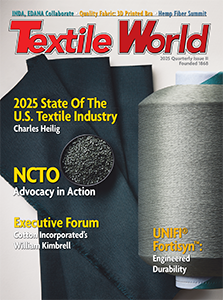
FAST Forward
Verona, Italy, set the stage for hosiery-related seminars, meetings and workshops, as well as
integrated exhibition areas at FAST 2001

FAST 2001, held earlier this spring in Verona, Italy, reinforced two popular views emerging
in the worlds textile industry. First, the industrys truly specialized exhibitions are destined to
enjoy increasing success in coming years. Second, the real developments in niche sectors will
derive increasingly from synergy established between the various partners: fiber producers;
machinery manufacturers; and those end-users convinced of the value of innovation.FAST 2001, the
Italian hosiery show, in its third incarnation, has once again demonstrated through the power of
concrete numbers the power of its attraction within the Italian hosiery market. FAST has also
consolidated its position within the international trade fair scene, according to Luis Ciocca,
chairman of the fairs organizing committee. Indeed, at the end of last year, an agreement was
reached with the American hosiery manufacturers association [The Hosiery Association], which
organizes the International Hosiery Exhibition (IHE) in Charlotte [N.C.]. According to the terms of
this agreement, the two fairs the Italian one and the American one will be staged alternately at
two-year intervals: IHE in 2003 and FAST in 2005, and so on. This is an excellent result, the fruit
of a collaboration that will continue in the years to come. The result, he said, will contribute to
the development and strengthening of both exhibitions. The third incarnation of FAST attracted
181 exhibitors, 110 of which were from outside Italy. More than 14,000 visitors from 93 countries
attended the fair. Additionally, according to FAST organizers, the caliber of visitors was
particularly encouraging, with 11,400 being either managers or highly qualified technicians. Of
this number, 5,200 were from Italy and 6,200 from other countries. A further breakdown of numbers
revealed there were 2,300 operators from Northern and Western Europe; 1,000 from Eastern Europe,
including Russia; 970 from the United States; and 950 from the Middle East.Visitors had access to a
number of carefully integrated exhibition areas: yarns and accessories; preparation machinery;
circular knitting machines; looping machines; finishing and packaging machines; accessories; and
services. Hosiery In The SpotlightIncluded within the fair was a convention entitled Hosiery
in the Spotlight, an event made up of an opening conference and several specialized workshops. As
part of the event, consumption trends in hosiery were analyzed by ACNielsen Sita, and the results
were presented at two well-attended lectures.Looking at the current market scenario, womens hosiery
is still characterized by a falling trend. Establishing 1997 consumption as the benchmark (equal to
100), consumption of tights, stockings and knee-high hosiery fell to 99 in 1998, 92 in 1999 and 85
in 2000. The market situation, however, seems to have stabilized in 2001, and improvement is
anticipated. For mens hosiery, consumption has increased an average of 2.5 percent annually. An
interesting element is that this increase in demand can be attributed mostly to women, who are
buying more and more mens hosiery made from natural fibers. Short mens socks, long rejected by
Italian customers, are beginning to gain ground on knee-highs.Figures released also show the
evolution of large retail shops. In the womens hosiery sector, chain stores are recording strong
growth levels, and specialist shops are increasing as well. In the mens sector, despite the
prominence of market stallholders (42 percent), modern distribution channels, particularly
hypermarkets, are gaining ground on others.Sid Smith, president of The Hosiery Association (THA),
discussed similarities and differences between the Italian and American markets.Hosiery in the
Spotlight closed with a roundtable meeting entitled Socks: Fetish or Fashion
Accessory First-Time ExhibitorsFashion and the hosiery market were not, however, the only
topics around which FAST 2001 evolved. This year, the Verona-based exhibition welcomed 12 hosiery
manufacturers for the first time: BBF Gambetti; Calzificio Milanese Luigi Ciocca; Calzificio FAP;
Calzificio REA; Calzedonia; CSP International; Franco Bombana; Golden Lady Group; Industria Bustese
Calze; Kayser Roth Corp.; Mura Collant; and VMC (Vignoni). For these companies, the secluded
Business Point area, specifically designed for the purpose, provided a place to meet customers and
established or prospective partners to discuss, compare notes, and develop new relationships and
initiatives. Technical Innovation

As well as providing confirmation of the numbers participating at the event, operators also
had high expectations for the technical developments anticipated to be unveiled at the show. In
particular, visitors were anxious to check out state-of-the-art machinery in seamless hosiery, the
area attracting the most international attention of late. But technological innovations were also
prevalent in other areas, with significant developments emerging in the area of fibers, yarns and
filaments. Among the most important initiatives in this area, have been collaborations between
machinery companies such as Santoni and Matex and fiber companies such as Bayer, Filartex, Filature
Miroglio, Franzoni Filati, Bonazzi Aquafil, Nylstar and others. But the development of fibers,
yarns and filaments was evident in non-Italian companies as well. Of particular note was the
innovative silver fiber, X-Static, of American design, for which successful applications have
recently been found in Italy. Apart from developments in this arena, however, it was the entire
Italian hosiery industry pipeline that dominated the FAST exhibition. This pipeline features raw
materials (polyamides, elastomers, latest-generation man-made polymer fibers, etc.), new yarns, the
exhaustive and sophisticated range of weaving machinery, and leading technologies for special
applications.
July 2001




